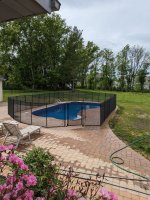Hey TFP members,
Hoping to get some suggestions/advice regarding replacing/repairing
loose natural stone coping on a
steel wall vinyl liner pool. The current coping is installed in a way that seems unconventional, and using the same approach with the repair process is unlikely to bring lasting results.
As the pool was acquired with the house, there are some other unconventional methods employed by whoever was the installer, but that's a topic for another day!
For reference, we are located in a
freeze-thaw climate.
Pool Details
- 2002 Build - Kidney Shape
- Steel Wall Vinyl Liner
- Plastic Steps
Coping Details
- Natural Stone on Mortar Bed
- Mortar Bed rests 50/50 on concrete (bond beam? collar?) and top of steel wall
- Diamond lath "attached" with screws to top flanges of steel wall
- Diagram attached below
Problem
- The coping is loose in many places - Repairing these segments will most likely disturb other well secured stones, so a full repair/replacement is in order.
- See attached pictures for reference.
Concern
- The coping is installed with a mortar bed applied over the concrete collar/bond beam and top flanges of the steel walls. In our situation, the concrete "collar" seems much smaller in width than what is typical. As a result, the width of the concrete is
equal to less than the width of the steel wall flange, effectively halving the surface area for achieving a good bond to the coping stones in a mortar installation.
- As mortar does not form a strong bond to metal, the installer had secured diamond lath with self tapping screws to the steel wall in what I assume is an attempt to prevent the mortar bed from fracturing and crumbling due to being applied over dissimilar materials; something akin to a reinforced mortar bed. Pulling up some of the loose stones revealed that the lath is corroded and brittle, to the point where it can be easily broken without any tools and the screws no longer serving their function.
- Refer to the diagram below for a visual representation.
Extra Thoughts
- Coping installations that forego mortar and instead opt for polyurethane adhesives seem to be quite common, but it doesn't seem to be a particularly long lasting solution according to some online sources and various threads here at TFP, especially in a freeze-thaw climate.
- Some detail a hybrid approach where both mortar and adhesive is used to install coping. There is a good example of this approach on Topic 3 of this Unilock Guide.
- An interesting solution, but I have doubts about its reliability in cases where mortar thickness exceeds 1/4", as it seems to be difficult to ensure consistent contact of the adhesive bead with a gap that large.
- Adds difficulty to leveling the stones due to the fast bonding nature of polyurethane adhesives, greatly reducing the amount of time any single stone can be adjusted.
- Potential case for an epoxy mortar?
I could not find any existing threads on TFP that could be of help, so any suggestions and best practices on how to tackle this are greatly appreciated!



